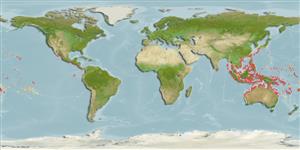Actinopterygii (ray-finned fishes) >
Perciformes (Perch-likes) >
Gobiidae (Gobies) > Gobiinae
Etymology: Gobiodon: Latin, gobius = gudgeon + Greek, odous = teeth (Ref. 45335).
Environment / Climate / Range
Ecology
Marine; reef-associated, usually 2 - 15 m (Ref. 27115). Tropical; 22°C - 28°C (Ref. 27115), preferred ?
Indo-West Pacific: Red Sea to Samoa, north to southern Japan, south to the Great Barrier Reef (Ref. 9710).
Size / Weight / Age
Maturity: Lm ? range ? - ? cm
Max length : 3.5 cm TL male/unsexed; (Ref. 2334)
Dorsal
spines
(total): 6 - 7;
Dorsal
soft rays
(total): 10;
Anal
spines: 1;
Anal
soft rays: 9. Characterized by mainly green body color with red to violet stripes or forming broken lines or row of spots on side; 4-5 reddish bars on head; absence of scales; complete pelvic fin frenum and basal membrane; depth of body at level of pelvic fins 2.2-2.7 in SL (Ref. 90102).
Found among branches of Acropora corals; a coral-commensal species (Ref. 72446). Solitary or in pairs, also found in reef crests and lagoons to 15 m (Ref 90102).
Life cycle and mating behavior
Maturity | Reproduction | Spawning | Eggs | Fecundity | Larvae
Randall, J.E., G.R. Allen and R.C. Steene, 1990. Fishes of the Great Barrier Reef and Coral Sea. University of Hawaii Press, Honolulu, Hawaii. 506 p. (Ref. 2334)
IUCN Red List Status (Ref. 115185)
CITES (Ref. 94142)
Not Evaluated
Threat to humans
Harmless
Human uses
Aquarium: commercial
More information
Common namesSynonymsMetabolismPredatorsEcotoxicologyReproductionMaturitySpawningFecundityEggsEgg development
ReferencesAquacultureAquaculture profileStrainsGeneticsAllele frequenciesHeritabilityDiseasesProcessingMass conversion
Tools
Special reports
Download XML
Internet sources
